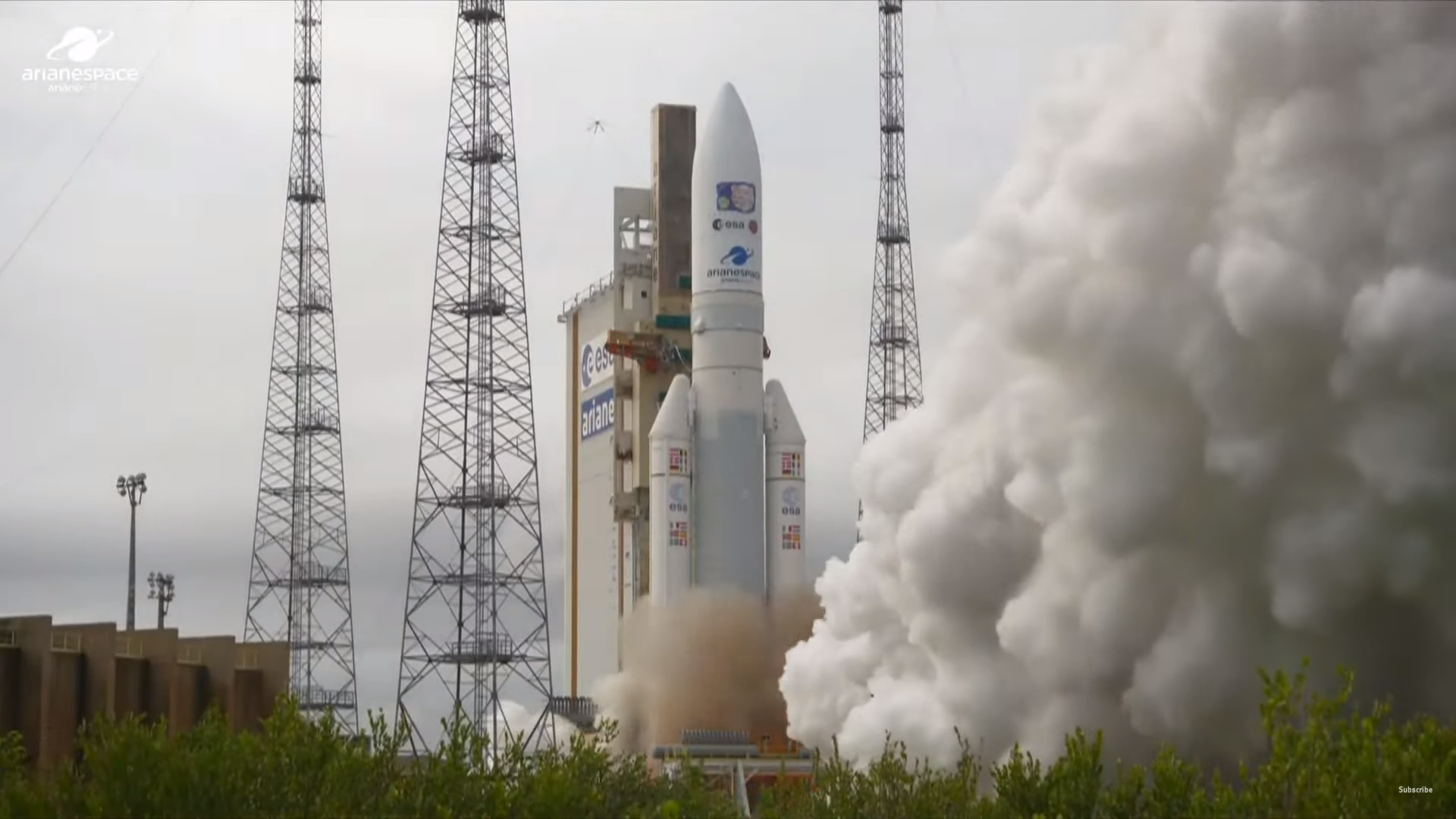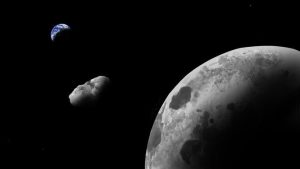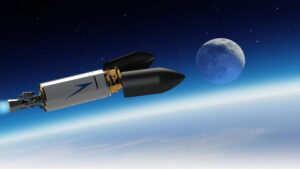JUICE launch ‘perfectly delivered’, Arianespace CEO says
14th Apr 2023
The latest European Space Agency mission to study Jupiter and its three largest moons was successfully launched today, on Friday 14th April. The Jupiter Icy Moons Explorer (JUICE) spacecraft launched atop an Ariane 5 rocket at 09:14 local time (13:14 GMT) from the spaceport in French Guiana – marking the last ESA launch with the soon-to-be-retired rocket from Kourou. The JUICE launch was delayed by one day due to the “risk of lightning” on Thursday, according to Arianespace.
The launch sequence went mostly according to plan, with slight delays in the signal acquisition with the New Norcia ground station in Australia. After blasting off, the ignition of the first stage occurred at 09:24 local time (13:24 GMT). The spacecraft then separated from the Ariane 5 at 09:43 local time, (13:43 GMT) and although the acquisition of signal was slightly late, ground systems made contact with JUICE at 10:05 (14:05 GMT). Ending a successful launch toward Jupiter, the final key milestone of the solar array deployment occurred at 10:34 (14:34 GMT).
Team Europe led to JUICE’s successful launch
The spacecraft will now begin its eight-year journey toward Jupiter to study its three largest moons – Ganymede, Europa, and Callisto – which hold large quantities of water that may harbor life. Its objectives are also to discover why Ganymede (the largest of the moons) is so unique, what its vast ocean is like, whether life could or has existed in the Jupiter system, and how a typical gas giant planet is formed.
“Today’s mission is a full success. Team Europe perfectly delivered, and I really want to pay tribute to all the teams who have made this success possible,” Arianespace CEO Stephane Israel said after the launch. “Arianespace and ArianeGroup team for sure, the supply chain, ESA, our customer, and Airbus Defence and Space who is the JUICE manufacturer. It is an absolutely perfect launch today and it is now the start of the journey for JUICE.”
While JUICE is an ESA-led mission, NASA, Japan’s JAXA, and the Israel Space Agency contributed to the spacecraft’s ten instruments. Further, the UK Space Agency has also invested about £9 million into JUICE,.
Successful launch with a one-second window
After launching the spacecraft, developed by Airbus Space and Defence, JUICE is now on a trajectory toward Jupiter and its moons – 11 years after it was first selected for an L-class mission as part of ESA’s Cosmic Vision Programme (flagship European-led missions to launch once every decade).
While contingency plans would include ESA having the ability to launch every day until the end of April, the launch window was far smaller than most – in fact, JUICE only had a one-second opportunity to blast off into space. While every launch requires nearly perfect weather and system readiness, JUICE has the added burden of an extremely small launch window. To push JUICE into the correct trajectory towards Jupiter, the launch window represented the perfect alignment of planets.
“We’re trying to stack up all the planets, or the gravity assist maneuvers to get to Jupiter with the minimum out of the three and a half tonnes of fuel,” Justin Byrne, head of Science Programs at Airbus Defence and Space told Space.com prior to the launch. The spacecraft is loaded with a significant amount of fuel for its voyage to aid the difficult maneuvers and planet flybys required to slingshot it to Jupiter. “So, we have a one-second launch window to inject JUICE into the right orbit”, Byrne said.
JUICE’s journey to Jupiter
Jupiter is just over 890 million kilometers away from Earth, and JUICE will have to navigate beyond the asteroid belt and complete several gravity-assist flybys to maintain speed and reach the planet. JUICE will complete a Lunar-Earth flyby in 2024, a Venus flyby in 2025, and an Earth flyby in both 2026 and 2029 before arriving at Jupiter in 2031.
Between July 2031 and November 2034, Jupiter will have completed 35 icy moon flybys, with two at Europa, 21 at Callisto, and 12 at Ganymede. JUICE’s 400km approach at Europa will mostly be for searching for biosignatures and pockets of water, understanding its geology, surface, subsurface, and activity. Its 200km approach at Callisto will mostly focus on understanding the environment around early Jupiter – as Callisto is the oldest surface in the solar system – and will give a glimpse of the early Jovian system. Lastly, JUICE will be the first spacecraft to enter the orbit of a moon other than our own, when it arrives at Ganymede in 2034. Ganymede is the largest of the three and will give ESA a glimpse of its vast, hidden ocean, and its magnetic field.
While previous missions have flown to Jupiter and its moons before – like NASA’s Galileo launched in 1989 – this spacecraft boasts “improved instrumentation to study oceans in detail”, according to Nicolas Altobelli, a planetary scientist at ESA working for the JUICE mission. “With this in mind, we wanted to see if these were possible habitats for life.”
Over the next two-and-a-half weeks, JUICE will deploy its 16-meter-long radar antenna, 10.6-meter-long magnetometer boom, and various other instruments to help the spacecraft study Jupiter.






![Best Astrophotos Of The Week: Moon Halo, Delta Heavy Rocket’s Last Launch, And More [12-19 April] Best Astrophotos Of The Week: Moon Halo, Delta Heavy Rocket’s Last Launch, And More [12-19 April]](https://orbitaltoday.com/wp-content/uploads/2024/04/Milky-Way-over-Damavand-peak-1-300x239.jpg)
Thank you for your comment! It will be visible on the site after moderation.